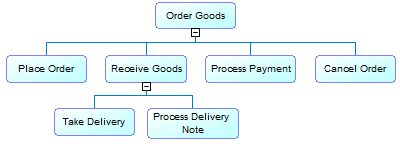A process is a manual or automated action, such as "Process order", or "Send a mail". Processes are the core object in the BPM. Processes can be atomic (without subprocesses) or decomposed/composite (containing subprocesses). Each decomposed process contains its own business process diagram, which shows its subprocesses as part of its control flow.
Processes can be created in models targeting any language, and are commonly used as the basis for other objects in languages other than Analysis.
In the following example, the Order Goods process is
decomposed in a process hierarchy diagram (see Process Hierarchy Diagrams (Analysis)) into
four subprocesses and the Receive Goods process is, in turn, decomposed
into two subprocesses:
The Order
Goods process contains a business process diagram (see Business Process Diagrams (Analysis)), modeling its control flow, which passes from one or
more starts to one or more ends (see Business Process Diagrams (Analysis)).
When the process gains control, it performs its actions and then, depending on the
result of the action, the flow is passed to another process. PowerDesigner allows you a
great deal of flexibility in your analysis of your processes. You can simply link
processes together to show the high-level control flow, or refine your model by
specifying their implementation (see Implementing Processes):
The Receive Goods process is decomposed, and so
its symbol displays a small plus sign overlay and it contains its own business process
diagram to model the control flow of its subprocesses

